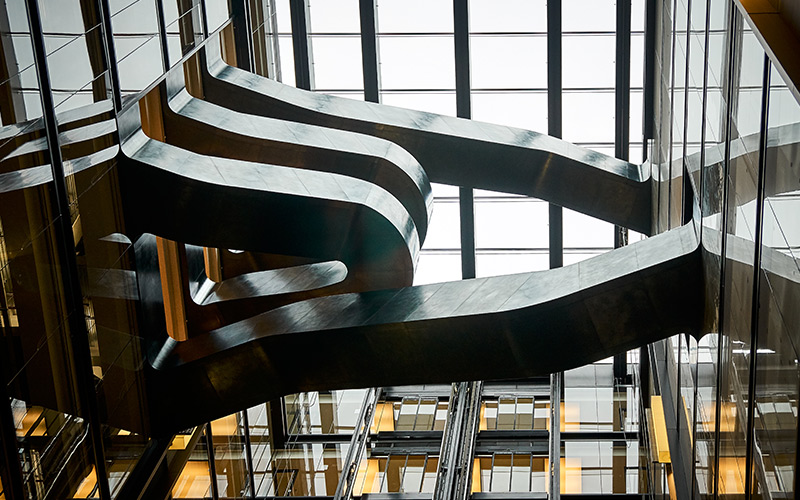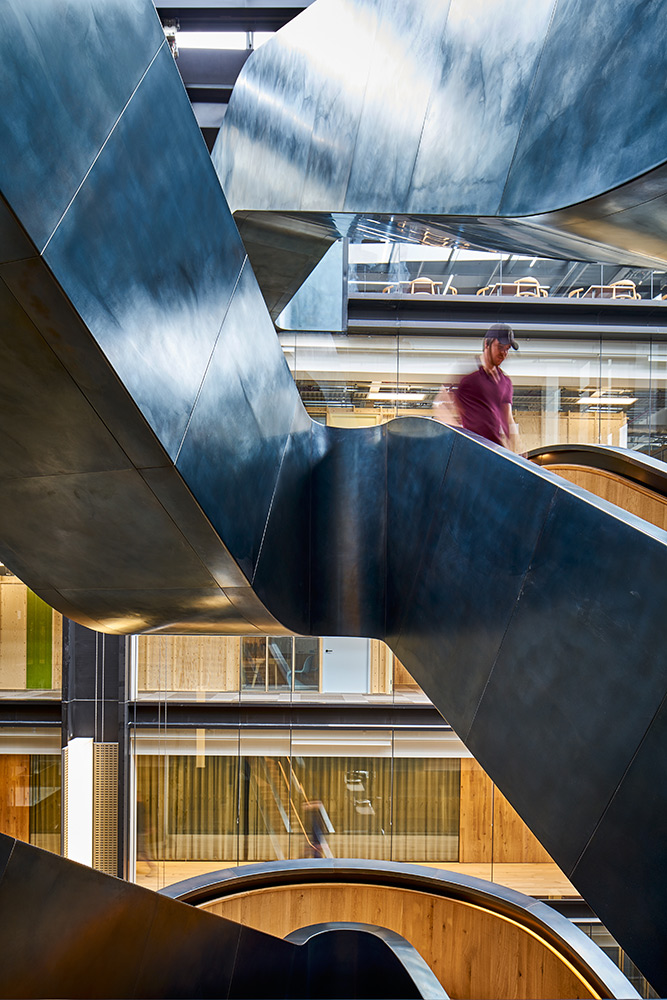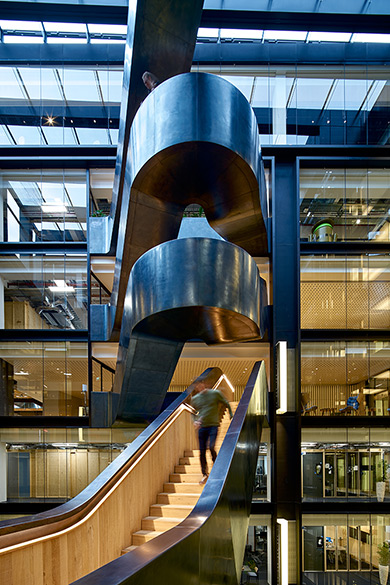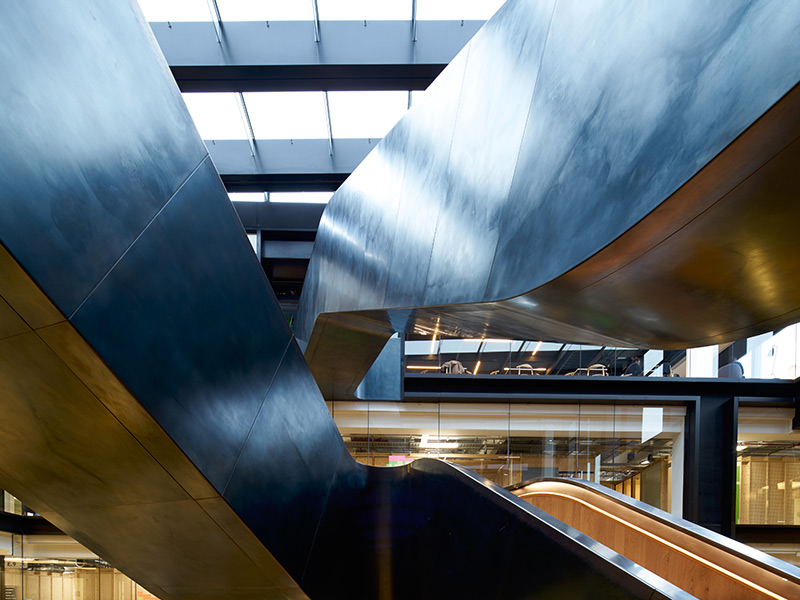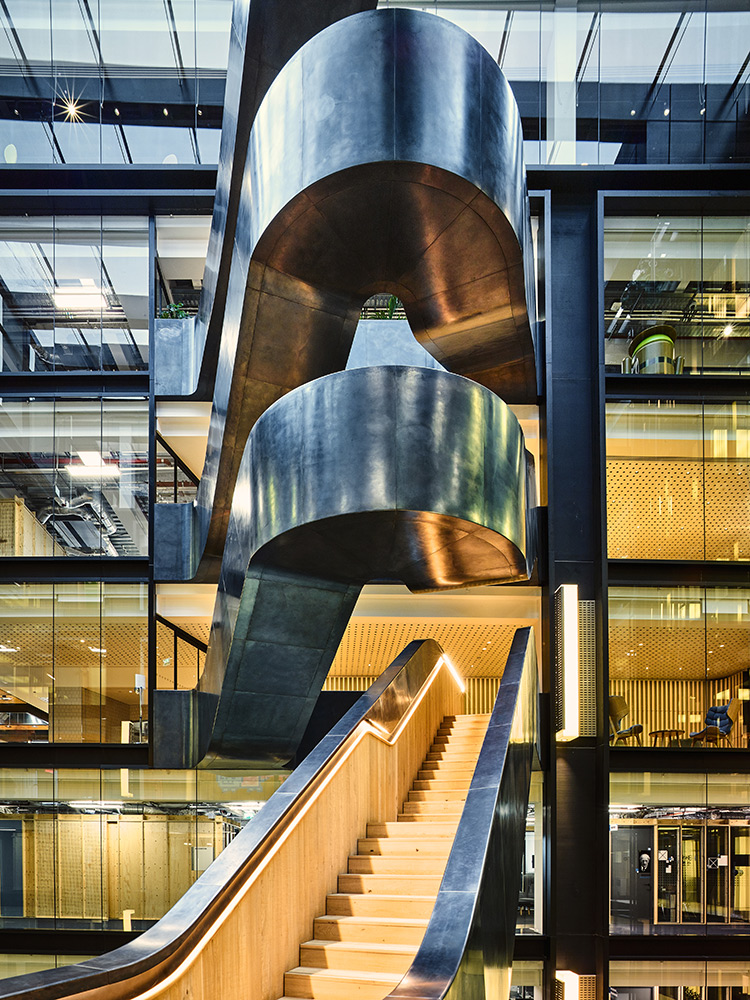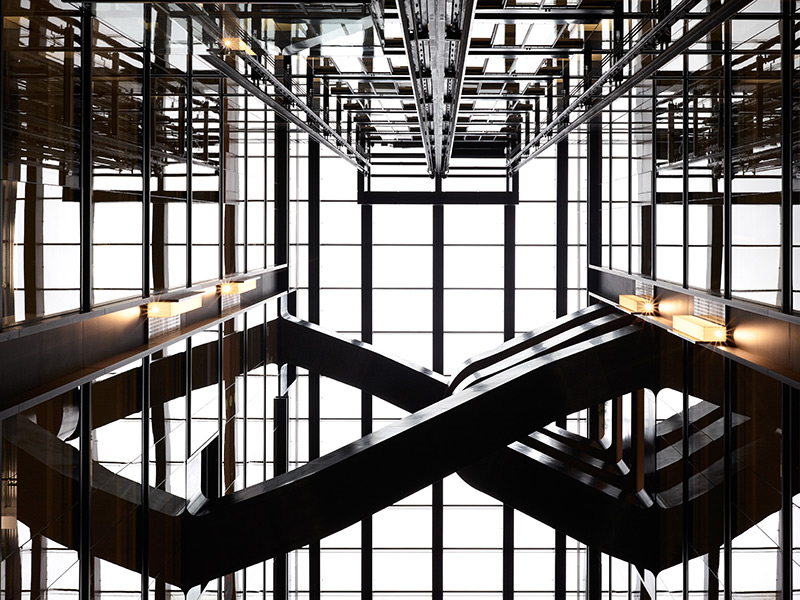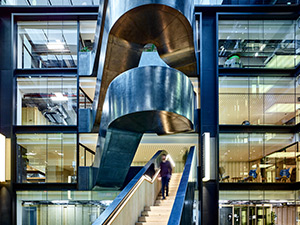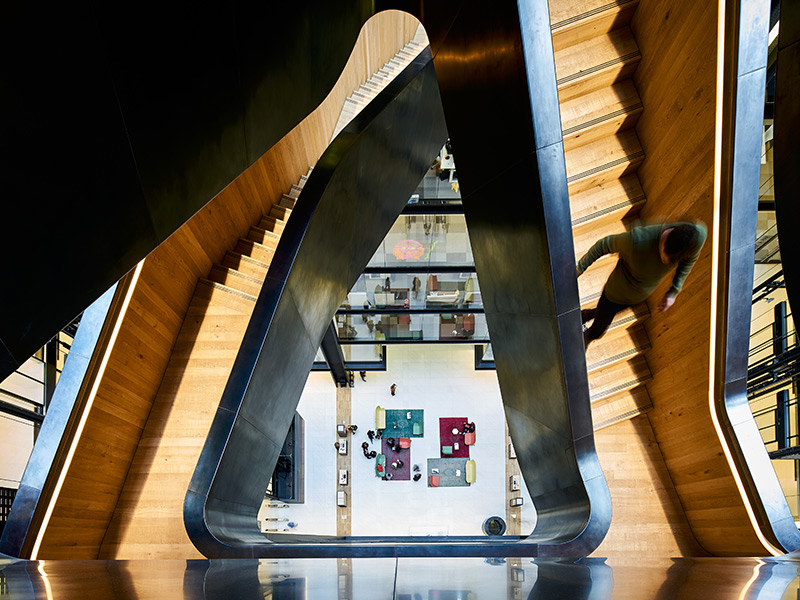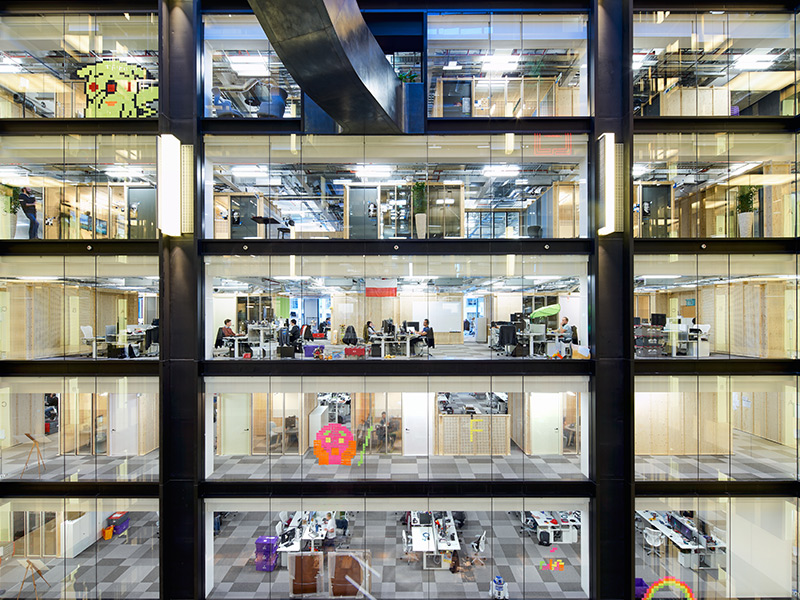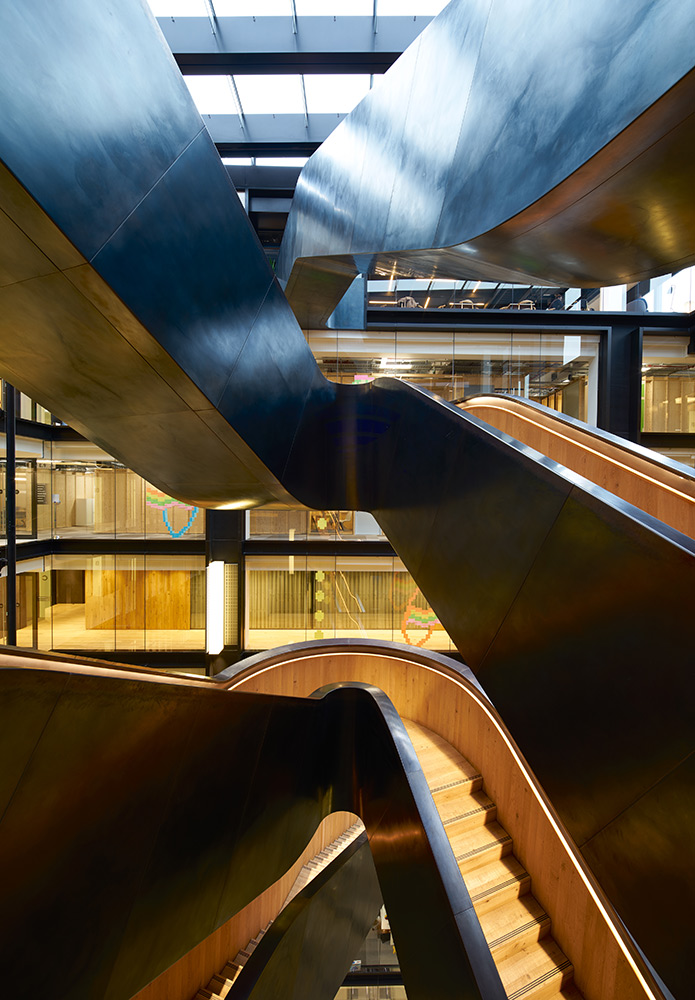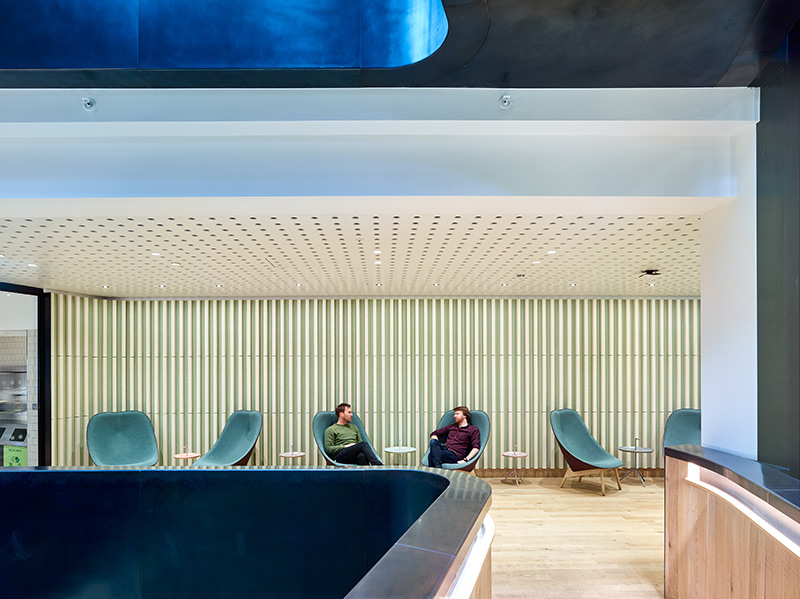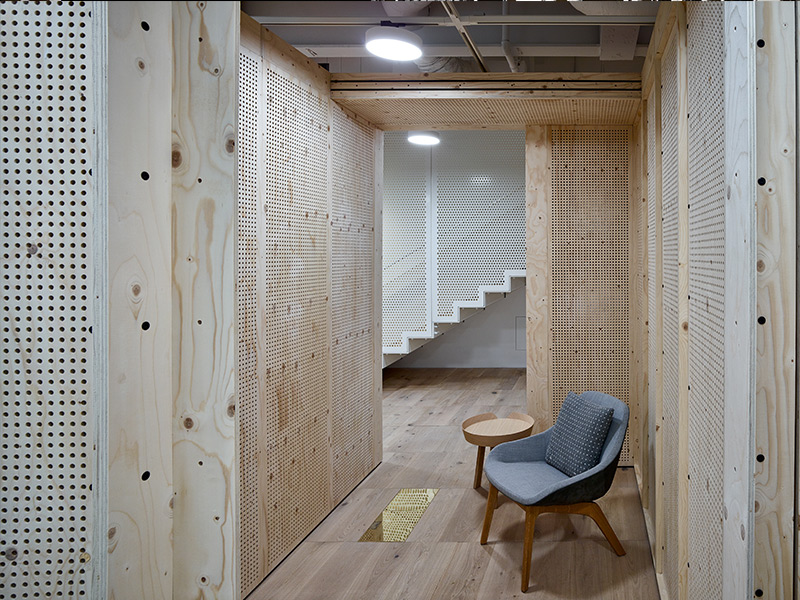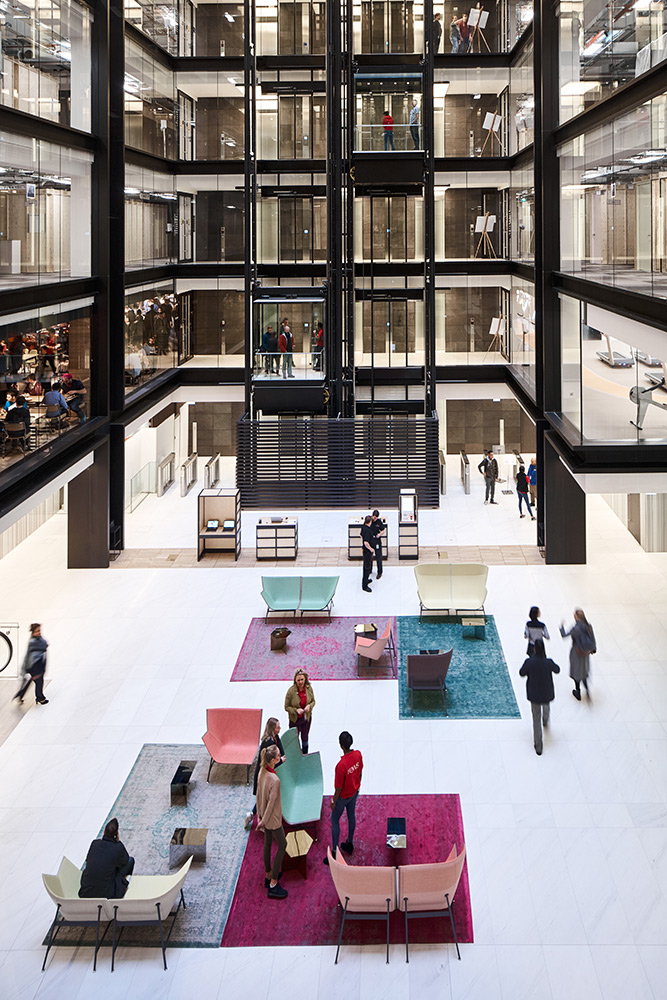Staircase in blackened stainless steel with over-wax finish for Google, 6 Pancras Square, London, UK
Architects: AHMM
Main contractor: ISG
Staircase fabrication, installation and finishing: John Desmond Ltd
Structural engineers for John Desmond Ltd: AECOM
Showing view from below the stairs. Photography by Tim Soar
A staircase as a ribbon-like sculpture

Ceri Davies, Associate Director of AHMM headed up the design team from conception through to installation on site.
AHMM Architects won the design competition in late 2013 presenting a design for the staircase that was to be a sinuous, sculptural ribbon. The staircase was designed to be a visual delight and a sculptural piece The balustrade is enclosed within the stair so is not visible and adds to the sculptural look.
This was the first time AHMM had executed a fit-out project as well as the architecture and their goal was to create an environment that wasn’t fixed, like a stage-set, but one that continued to create a changing dynamic and a joyful space in which to work.
Encouraging people to create a dynamic space
There are some very stylish lifts however Google wanted an inspirational alternative to these. They wanted to encourage Googlers to not be sedentary but to get up and move around simultaneously relieving pressure on lift usage.
Google wished to have an internal staircase rather than have the Googlers rely on the landlord’s four staircases which were all security-restricted and needed ID badges and swipe cards to access and were not created for the free flow of people.
The centre of an atrium can be a fishbowl however this central staircase encourages life and activity within this potentially inactive space. It was Google’s wish that this would create friendly “friction” and chance encounters, stimulation and engagement between overseas visitors and in-house Googlers, sparking new ideas. The staircase creates visibility and movement and is a distinct step away from a corporate style. In Feng Shui terms, bringing energy into the centre of this potentially void space is seen as a positive way to break down barriers and connect people in the whole of the building.
Design development
Originally the staircase was to be clad in mirrored stainless steel. Whilst pondering the effect of this material, Ceri had a breakthrough thought – the staircase would certainly be a showpiece in a mirrored finish but it thematically it would be set apart from the rest of the building. If the staircase were clad in a more naturalistic material it would become more integrated with the atrium and the surrounding space. Blackened steel would certainly be a connection with the black powder-coated aluminium glazing bars existing throughout the atrium. However the blackened steel would be unlike the powder-coated aluminium in that having once been installed it would not be a static finish and simply retain its original appearance. The blackened steel could have its own dynamic, developing a patina over time and appearing differently in changing light levels within the atrium. Instead of a varnish or polymer coating it could simply have a rubbed waxed finish which would need reapplying but would also be a part of the changing element of the design. So the design was altered to the blackened and waxed stainless steel finish that now brings such a dramatic sculptural element to the building.
Offsetting vertigo
Key concerns were to encourage people who might be thinking “How do I get to it?” and those who might be intimidated by the height, for example on the eighth and ninth floors. The statutory balustrade height was exceeded in order to create a sense of safety and people with vertigo need never look over it if they don’t want to. It is gradually raised in height the higher the staircase ascends giving the user a sense of protection.
Fabrication
As the staircase had to be fabricated off-site it was made in sections and then taken by road to the site.
Ceri says “The design team visited the John Desmond workshops many times whilst the sections were fabricated. This proved to be a vital part of understanding the methods of welding and cutting and how each millimetre impacted on the overall feasibility of the design and its installation.”
There was a constant “bartering” of design elements between the architectural members of the team and those responsible for the the structural design and the fabrication. It was crucial to the aesthetic that the staircase was not propped at any of its points as this would negate the effect of a sculptural shape. To avoid the need for propping the beam edges were strengthened and the dog-legs of the staircase were made self-supporting by means of a cantilever from the floorplates out into the atrium. Only through a truly open and sharing collaboration could the eventual design have been achieved as initially the engineers were concerned that it might need props.
The occupants move in
A year later the lower part of the building was also acquired however the work had advanced too far to take the staircase to the lower levels. Around 800 staff were to be based in 15,000sq m of offices at 6 Pancras Square initially. This staircase is in Phase I.
The occupants moved in as part of Phase I during July 2016 and took up residence of the entire building at the end of November 2016.
The staircase, now the heart of the building, has become a much talked-about feature of The Pancras Square offices being instagrammed and featuring in social media. The top floor coffee area becomes very popular during lunchtimes especially with the occupants of the lower part of the building who do not have a showpiece staircase of their own and exhibit a certain amount of stair envy.
The design in context – Flexible space
A buzz word used in design, of which we are all aware, is Flexibility. For Google this meant true fluidity as their business could change overnight – acquiring new businesses and carrying out other, rapid key restructures. Having an office layout that required six to ten weeks to be altered – from original request to dismantling partition to installing new partition – was an incompatible way of working. Google needed modular space that could be reconfigured as quickly as they might take over a new company and set it up in their HQ.
The spaces that had a longer life-span, such as the gyms and restaurants were located centrally within the floor-plates with the surrounding space designed from plywood cassettes that can be be dismantled and reassembled.
Jack Rooms
Gordon Emm of Brown and Carroll explains how they responded to Google’s need for continually flexible space. “The Jack Rooms concept is based on something similar to Lego in that endless permutations are possible. Each spruce plywood cassette is 2.4m by 600mm in size and has a flat, matt sealant to protect the surface and maintain the natural look. The Jack team can install a new room in half a day yet the life-expectancy of the cassettes is twenty-plus years and is completely in keeping with Google’s Healthy Materials policy”
Contact John Desmond Ltd to discuss a specialist metal finish for your project. [email protected].
Showing the snaking sinuosity of the design – Google offices, 6 Pancras Square, London, UK – Photography by Tim Soa.
Googlers enjoying the stairs and the view from a half-landing Google offices, 6 Pancras Square, London, UK
Photography by Tim Soar
The natural waxed finish on the blackened stainless steel and the varying effects of daylight that play on it Google offices, 6 Pancras Square, London, UK
Photography by Tim Soar
Stairs in the sky – how to get them there

Alex Pashouros, Project Manager at John Desmond Ltd says “We were asked to tender by ISG as one of the very few companies able to carry out such a complicated installation.
Logistically, creating a staircase in a completely finished building, which was never designed to take a staircase, particularly a staircase of this size, was a challenge. The question was how to get it into an atrium that was 50 metres high. The stairs run from the seventh to the eighth floor, eighth to ninth floor, ninth to tenth floor and tenth to the eleventh floor each consisting of two flights with a half-landing in between.
Originally the plan was to crane small sections of the staircase in via a terrace on the eighth floor. From here the plan was to push the sections out onto a scaffold and build from there. However the planning-protected taxi-rank occupying a critical position in the street outside meant that insufficient “crane-time” could be secured to carry out this plan.
So the eventual strategy was to build a scaffold up through the whole atrium and use a hoist to lift all the staircase sections to a crash deck positioned between the sixth and seventh floors.
Resonating frequency
The staircase had to be carefully considered in terms of its vibrational frequency as the repeated U shape is one that will naturally create frequency issues. If the steel structure was too stiff then the resonance from each tread would ripple out to the surrounding floors making people ‘s desks vibrate. If the structure was too flexible then each step would be too bouncy to be comfortable and give the user a most insecure sensation.
Back-span beams had to be engineered to ensure the correct frequency level that using the stairs remained a comfortable experience.
On-going design
A few changes were needed once work commenced, the superstructure needed to be of larger dimensions than originally planned as to stiffen the structure it needed to be spliced to get it into the building.
The stair had to be shortened at the fourth stair back towards the building as the original design meant the stair was cantilevered too far out and wobbled too much.”
Contact Alex on 020 8946 8295 to discuss your design and installation project.
Beautiful, sustainable, practical

Peter Smith, Senior Architect, AHMM was one of the first people involved in this project when it began in 2013. AHMM were invited to prepare a design for the fit out for the top half of the Pancras Square building with work due to commence in February 2015. However, two months before work was due to begin the whole scope of the project was dramatically altered when Google took the entire building, rather than just the top half, and now needed to redevelop it in its entirety including the eleventh floor which had previously been allocated to a French bank.
Logistics
A scaffold was built full height into the atrium however the atrium itself was not strong enough to support the scaffold so the scaffold was proposed to be propped from the basement floor, two floors below the ground level. However Google acquired the basement during this planning stage and, now having taken the lease for the whole building, this was knocked out to create two recording studios, both two storeys high, to provide the London YouTube Space. This meant nowhere from which to prop the scaffolding.
ISG had to bring onto site 1200 – 1300 deep beams and create a platform from which to build the scaffolding which was an extensive undertaking in engineering for the temporary works.
Solving the construction puzzle

Sem Kyegombe is Project Director at ISG plc and directed the Google project.
The initial product selection was an extended process as the design brief was that the staircase had an industrial and honest look but this was countered by the fact that the building was not owned by Google. This meant that any additions to the building needed to be harmonious with the overall style. Sem says “Now time has passed the wax coating is developing a patina as it was intended to do and the exposed primary steel members contribute to the architectural honesty of the structure.”
The arrival at the eventual wax coating for the stainless steel was through a process of sampling and assessment involving close liaison with John Desmond, ISG and the project team. To create an integrated feel, the treads and risers needed to be seamless with the building’s floorplate and therefore had to be obtained from the same timber supplier despite the complexity of it being installed on site by three different contractors.
Another major challenge was how to build the staircase within the atrium. Initially it was considered to remove sections of the building to create access but the eventual solution was to build an internal scaffold gantry with the load being borne by the pile caps and avoiding any stress being placed on the floor slabs. The number of components was crucial as too many would create an unacceptable risk to the structure.
Access to the building was via Pancras Square which is famously busy most of the time. This meant that all materials had to be brought on site during night-time hours which was done using dollies and forklifts. An additional restriction was that the structural elements had to be brought into the building through the existing revolving doors and were therefore limited to 2.5 or 3m in length.
Because of the access and space restrictions the build methodology had to be minutely and intricately planned. Materials had to be brought on site in a highly specific sequence, firstly those for the scaffold gantry and then the stair superstructure, components and panels. To give an indication of the scale of the scaffold gantry, its steel members were larger than those used for the primary steelwork in the original building.
The stair panels fabricated by John Desmond were at the end of the delivery process and again, had to be brought in strictly according to the build sequence. John Desmond built entire stair superstructure sections off-site and fully clad these with the panels. These were then dis-assembled with the superstructures being sent on site whilst the panels were coloured and finished. This was carried out for each stair section and was project-managed to synchronise with the crucial delivery sequence.
Working with Google’s Biophilic Design philosophy
The Google approach to eco-friendly environments is more than a system, it is a philosophy. The purpose of it is to enable Googlers to feel energised, inspired and motivated through the use of natural materials and elements that occur in nature. Natural materials were specified for the stair finishes with the interior being of rough-sawn timber to accentuate its relationship to a tree, a very different statement to that of a highly polished wood.
Level 8 and level 11 are destination floors and provide balconies with views across London from the Olympic stadium in the East to Wembley in the West. By not having working desks on the floors with these views means all Googlers have equal access to the balconies and on fine days the facility of being outside. The sensations generated are emotional and in response to the natural world and elements – an outcome which is at the core of Biophilia.
The project team worked closely with several departments and individuals within Google. One important team was the Google E team, based in California, who are responsible for ensuring the best environmental and sustainability measures are implemented. The project had its own Carbon consultant who calculated the amounts of carbon that would be generated from the building’s use and recommended ways in which this could be reduced.
Google’s Healthy Materials Programme
Alicia Freire of Twin & Earth, an engineering and sustainability consultancy, was in charge of ensuring that John Desmond met the stringent Healthy Materials compliancy standards. The Healthy Materials standards go beyond those set by LEEDS and BREEAM and relate to a range of issues including recycled content, waste disposal and precise provenance of materials used. For John Desmond this meant tracking every piece of material used coming from any part of the world, to ensure compliancy. There are also strict criteria in relation to working on site with processes such as dust-generation being rigorously controlled.
Alicia says “The steel market is one in which it is historically very difficult to track materials however all suppliers were selected, and re-selected, on the basis that they could disclose the necessary data which would meet the high standards of the Healthy Materials policy.
John Desmond allocated two of their internal staff, Jenny and Joyce, to pursue all of the crucial information on steel, finishes and treatments. The huge on-going benefit from this Google exercise is that John Desmond are now operating comfortably within the most stringent and demanding sustainability standards in the construction industry”
The project served as a pilot scheme for Google’s in-house environmental assessment tool, Portico, also known as The Healthy Materials Tool. The tool assesses every single component of all materials proposed for use within the building to discover whether any harmful chemicals are present that could affect the health of people or the environment. This required a ninety-nine per cent disclosure by suppliers of the contents of their products including paints which famously have many, often secret, ingredients.
This rigorous process meant that many products were re-specified or replacement suppliers appointed to ensure compliance with Google’s standards. The target set by Google for the St Pancras building was between sixty and seventy per cent conformability but in actual fact, to everyone’s delight, the eventual score was one hundred per cent. Again, at the core of this success was collaboration. Information was shared between contractors and subcontractors so that products that had “passed” could be identified and used rather than adding more “new” products to be assessed and potentially rejected.
Practical purposes
The staircase was designed for other useful purposes. The surrounding fascia glass of the atrium requires cleaning and also replacing when damaged. The points at the widest end of the U shape of the stair course allow for the width of a maintenance cradle to drop down between them.
Concealed by a flat disc in the base of the staircase flights is a “lifting eye”. This is a ring into which a hook can be connected thus converting the stair flight into a lifting beam from which replacement windows and materials can be hoisted up the atrium.
From the half-landings it is possible to look down onto the other levels.
The rough-hewn timber treads – contrasting with the steel very much like the rough interior of a nut with a highly polished shell.
Google offices, 6 Pancras Square, London, UK
Photography by Tim Soar
The wax finish on the blackened stainless steel develops as a patina over time.
Google offices, 6 Pancras Square, London, UK
Photography by Tim Soar
The staircase finishes seamlessly joining with the floorplates of the building.
Google offices, 6 Pancras Square, London, UK
Photography by Tim Soar
The structural engineering

David Knowles, MEng MA (Cantab.) CEng MICE, of AECOM was the structural engineer employed by John Desmond Ltd as the structural designer. David was responsible for all the structural analysis and design on their behalf and co-ordinating with the clients engineers, Waterman, regarding the existing office structure. The load-bearing nature of the staircase and the safety of the users was the key focus. When people use staircases they tend to run up or down them which creates vibration at a higher frequency than a normal floor. With the design of this staircase being U-shapes cantilevering into the atrium there would be a significant oscillations if no stiffening were applied. A small amount of movement in the staircase is acceptable.
The staircase also had to be “buildable” so that it could be erected on site. As mentioned earlier, sections had to be built at the John Desmond workshops however there were constraints on the section sizes. They had to fit into vehicles to be transported to site and they could not be too heavy to be lifted into place once in situ. David’s challenge was to work out how the staircase could be divided into component pieces. Intense liaison was carried out between AECOM and John Desmond. David sketched drawings showing the component sections and connections and John Desmond drew up their technical drawings accordingly and both were discussed in depth – this process was repeated until all were agreed on the final solution which gave the architects the impressive design and pleasing simplicity they had created with a soundly engineered structure to support it.
Contact John Desmond Ltd to discuss your staircase design and installation project
Footnote on the stair components
Altogether there were 66 sections for the super-structure including truss elements, stair-treads and stringers and cross braces. Stair-treads and stringers were all welded to allow diaphragm action.
End parts were fully fabricated box sections in 60mm steel plate. The half-landing for Stair Four was built in one piece but kept under the 900kg weight-restriction to enable it to be lifted within the atrium. Cladding panels numbered 162 in total.
To see the John Desmond Ltd staircase drawings for the Google project, click here
